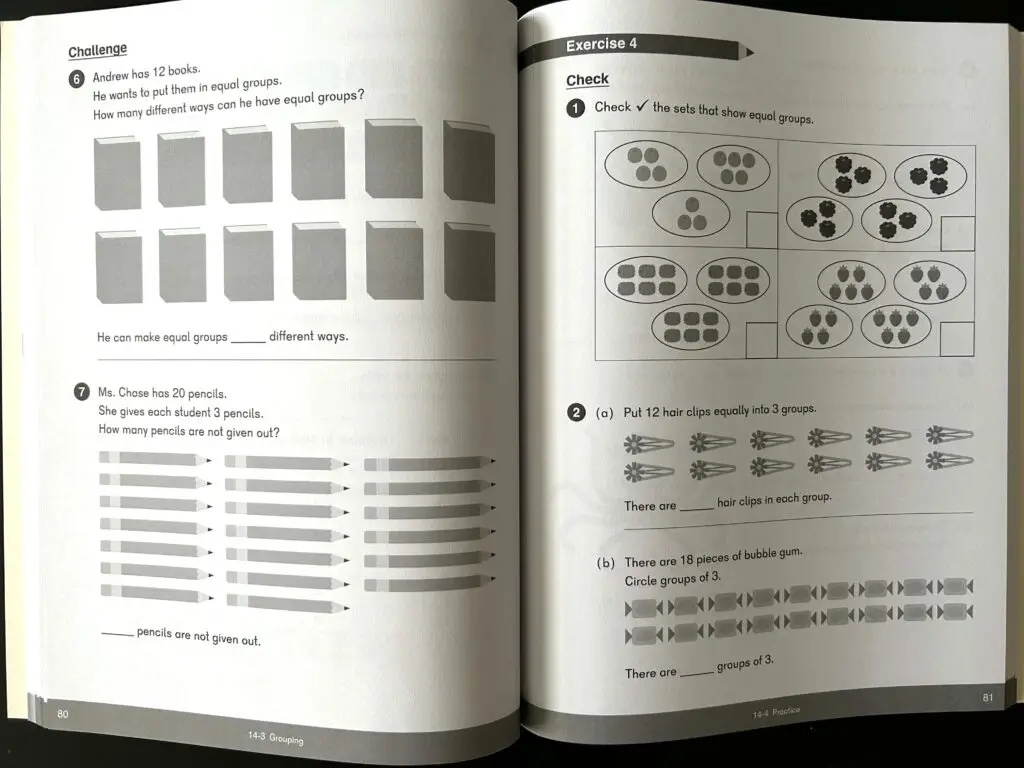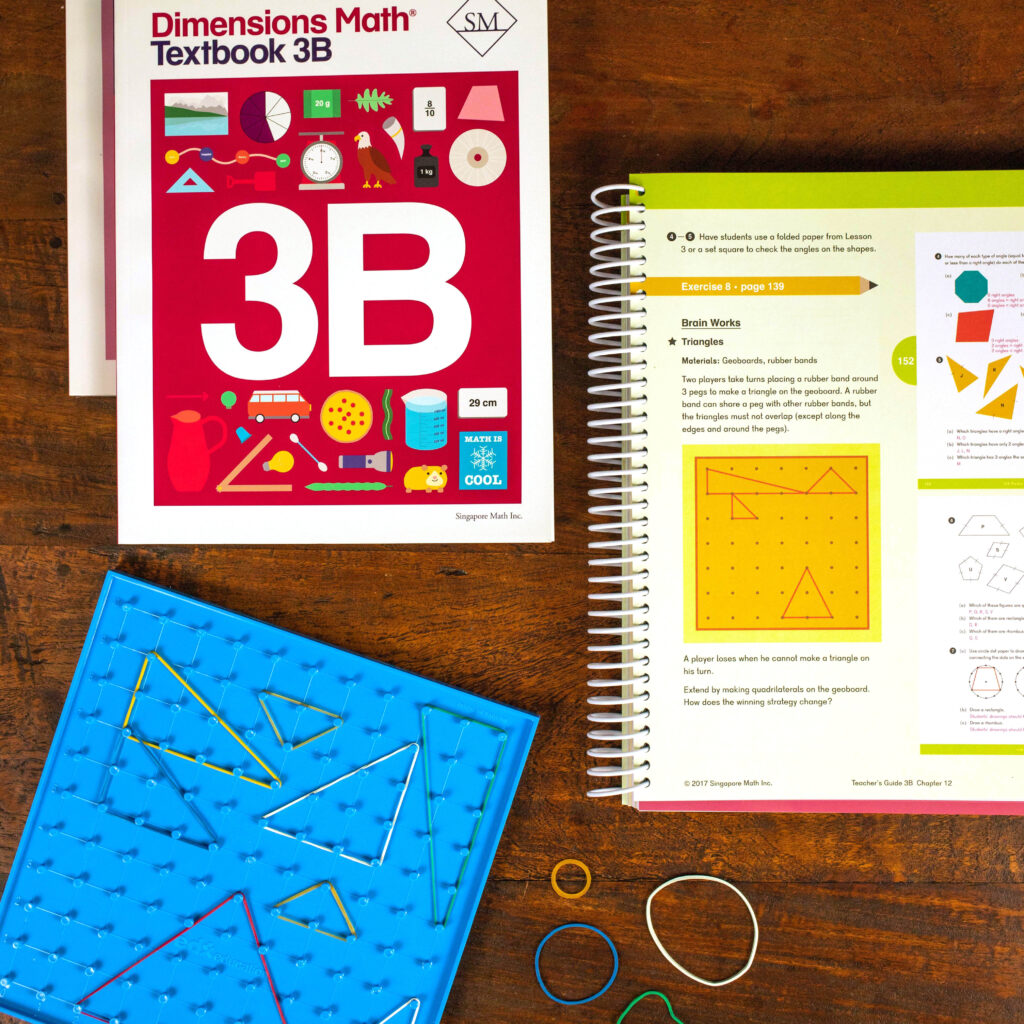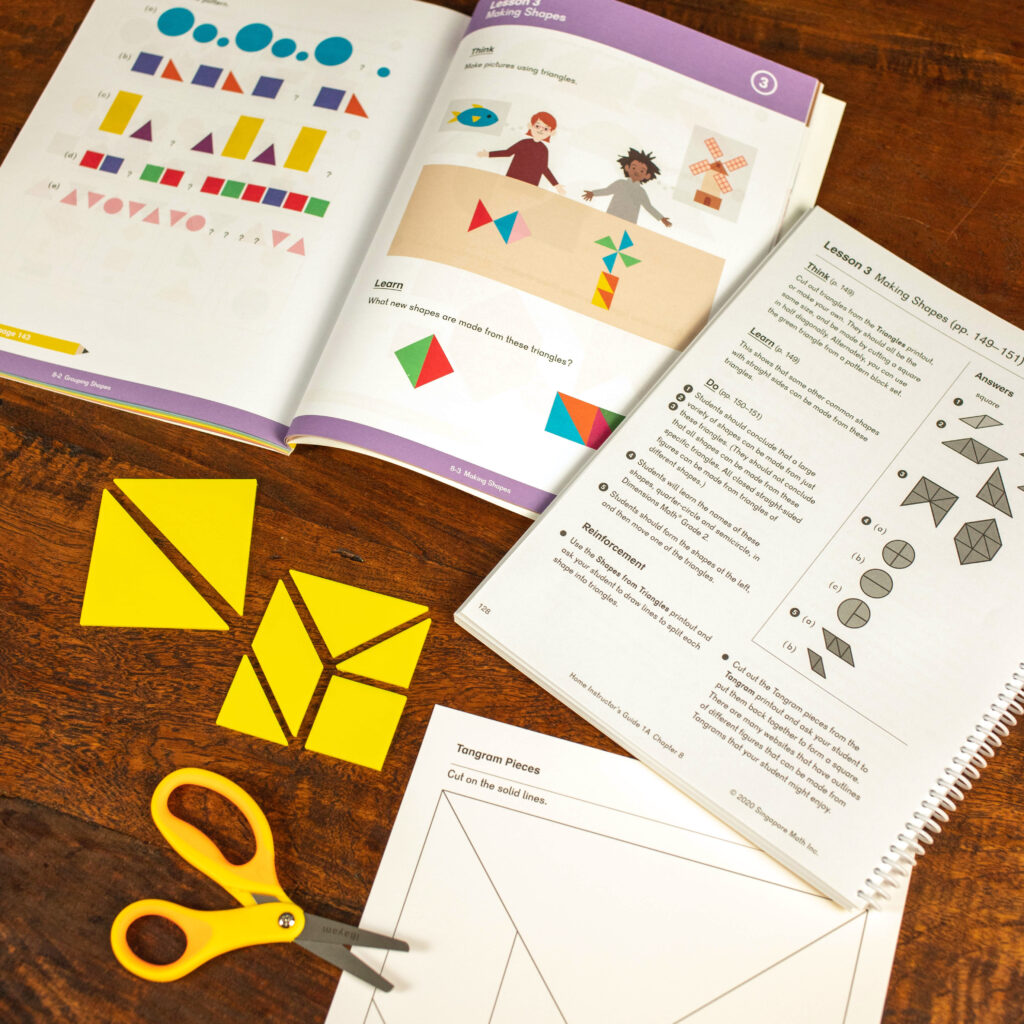Benefits of the Singapore Math Method for Homeschoolers
Just so you know, this post contains affiliate links. That means if you use them to make a purchase, I may earn a commission. You can read my full affiliate disclosure HERE.
When other moms find out that I’m a former high school math teacher, you can bet one of the questions they ask me is:
“What homeschool math curriculum do you recommend??”
I know they’re secretly hoping I have the magic answer, something that will solve all of their math woes and help their kids love this subject.
They’re thinking that maybe I know something they don’t, that I have true insight into which curriculum is “the best”.
I am probably going to disappoint you here: I don’t.
The honest reason? If you’ve been homeschooling for a while, you already know that the “perfect” curriculum just doesn’t exist. That your kids are different than mine. And you can take my recommendations until the cows come home, but ultimately, you know your kids, your schedule, and your budget best…and homeschool curriculum can be a lot of trial and error.
That being said…
As a former math teacher, there is a method to teaching math that I truly believe helps give kids a greater depth of understanding of concepts, builds their problem solving and critical thinking skills, and really helps prepare them for upper-level math classes.
I recommend it to all homeschooling parents with elementary-aged kids who are looking for a hands-on, parent-led curriculum.
That’s the Singapore math method.
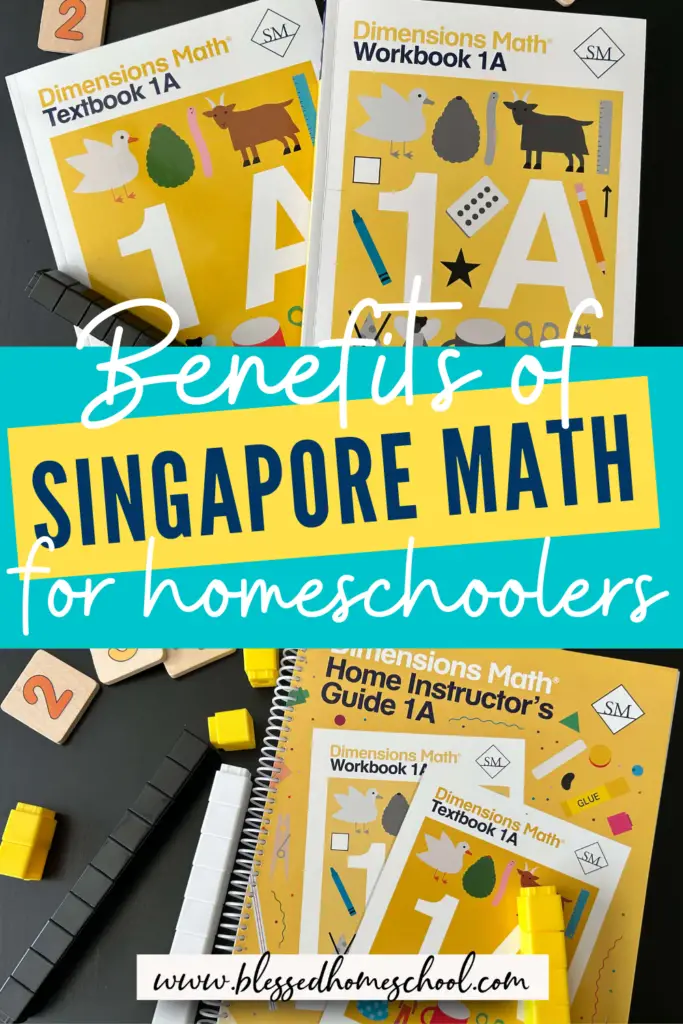
The way math is taught through this method is really how I always DESIRED to teach math to my students, but was often met with time constraints, standardized testing obligations, and honestly, the struggle of teaching kids who maybe didn’t have that depth of knowledge, or confidence in math, to build on.
In my humble opinion, the Singapore math approach, is truly one of the best methods out there.
What’s the difference between Singapore math method and typical U.S. math programs?
The Singapore math method puts a big emphasis on problem solving, mental math, and helping kids actually understand why math works and actively think about the processes they are doing.
It emphasizes “why” something works over “how” to do it.
This is a big contrast to how math is often traditionally taught, where kids see an example worked out and then solve a bunch of problems just like it (but with different numbers).
Singapore Math is going to push your kids’ thinking, because they can’t rely on that typical replication process.

Throughout any of their programs, you’ll find their concrete-pictorial-abstract approach, along with a focus on mental math and model drawing, which has shown to help kids transition better to algebra and more complex math problems in later years.
For example, with the Singapore mathematics method, you might use visual representation, physical objects, and story and word problems to help your kids truly grasp the concept that division is a way to distribute items equally before moving on to more abstract concepts or memorizing facts.
Or, your kids might problem solve how to measure 3/4 c. of flour for a recipe if they only have 1/2 c., before even being introduced to the process of equivalent fractions and how to manipulate them.
History of Singapore Math
“Singapore math” in general refers to the math curriculum that was developed and used in Singapore, and it has consistently helped kids achieve high levels of success in math.
Founder Dawn Thomas began the company, Singapore Math, in the late 90’s after moving to the United States from Singapore. She introduced the Primary Mathematics original curriculum to a small group of parents who wanted more for their kids than the “surface-level” math being taught in local public schools.
The interest grew quickly, and many parents, educators, and professors began discussing and implementing Singapore Math curriculum. The company continues to grow today, producing resources to help bring this model of math education to as many kids as possible.
Using Singapore Math in our homeschool
When I responded to God’s call to homeschool my kids, I bombarded my best friend with questions, and she recommended Singapore Math to me.
So I began using Primary Mathematics 1A and 1B with my son (which was the only option available at the time), and we used this through first grade and about half of his second grade year.
When we had moved on to Primary Mathematics 2A, Singapore Math came out with their new Dimensions Math program. Dimensions Math was kind of like a sequel to Primary Mathematics, and I was drawn to the new format and the way the concepts were explained. So I actually purchased 2B to finish out our second grade year, and I snagged the Kindergarten books for my girls too.
I loved the updates to the curriculum. I’m going to share a bit more about Dimensions Math below, but if you’d like a comparison between Primary Mathematics and Dimensions Math, check out my video review below:
Is Singapore Math good for homeschool?
Are you are considering Singapore Math as a possible curriculum option for your homeschool? Here are some pros and cons to consider.
Pros of Singapore Math Curriculum
Problem Solving Focus – Kids do more than just memorize processes in Singapore Math; they are taught in ways that they build deep conceptual understandings about why math works, which will help them as they then move to computation, and eventually take higher-level math courses.
Mental math skills and solid number sense come into play heavily as students solve problems, which will help them work efficiently as they move through their math education.
Concrete-Pictorial-Abstract Approach – I mentioned the CPA approach a bit above, and it’s a key strategy you’ll find throughout Singapore Math curriculum that helps kids build those deep understandings. They’ll progress through lessons first using hands-on manipulatives, then moving to representing a math problem with pictures in the pictorial phase, and then finally, by using numbers and math symbols.

Mastery of Topics – I think when people hear a math curriculum is a “mastery” curriculum, they worry that they will learn a topic and then never review it again. I say the Singapore math method is mastery because it absolutely encourages a mastery of topics…which is a good thing!
And while there is less repetition of previous lessons, I think that as kids truly understand what they are doing and learn how to think critically, this may become less necessary. They are continually building on previously learned skills.
However, Dimensions Math includes Reviews and Assessments periodically throughout the year in addition to the regular lessons, which ensures long-term retention of skills.
Comprehensive Home Instructor Guide (HIG) – The Home Instructor guide is made specifically with homeschooling parents in mind, and is so easy to follow. I love how the sections are clearly outlined so you know exactly what to do. You are also given plenty of reasoning for solutions, especially in regards to follow-up questions to ask your kids or where and how you might need to give them extra assistance.
Engaging Lessons – The textbooks and workbooks are colorful with lots of pictures and room for kids to work. The use of different manipulatives and suggested activities make it fun for kids to learn math.
It’s Cost Effective – The price varies slightly between the Singapore Math programs. But you’re looking at around $150 for a (brand new) full year’s math curriculum. If you can find a used HIG that will save you some money, but you will need a textbook and workbook for each child, as they are consumable.
Optional Video Subscription – The Dimensions Math course now has a Dimensions Math At Home video subscription available for Grades 1-6. These videos give lesson instructions for the entire course, and your kids would use them alongside their textbooks and workbooks.
This is definitely not a required purchase, but might be a helpful option if you want some assistance in teaching the lessons.
Singapore Math Live is their option for Primary Mathematics video instruction and Dimensions Math for Grades 7 & 8.
Finally, they have a Facebook community you can join if you’d like, where you can collaborate with other families using Singapore Math. This is a great place to ask questions, get tips for teaching using the Singapore math method, and engage with other families.
Possible Drawbacks to Singapore Math Curriculum
Prep Time – As with probably most math curriculums (unless you are using an online program), this isn’t exactly open-and-go. I don’t think it necessarily takes too much time to prep, but you will want to make sure to read through the lesson introductions to make sure you understand what you’ll be teaching, and get any manipulatives ready to go.
The more comfortable you are with math, the less prep you may need, but if it’s not your strong point, you might even want to work through some of the Singapore math problems so you can best teach them to your kids.
A Whole New Approach – Singapore math is a highly effective teaching approach, but it’s a completely different way of approaching math. If you prefer a more traditional style, this might not be for you.
Finally, I think that if you have multiple kids, it might be challenging to work through a math program like this with each one at different levels. This will largely depend on your schedule and what other activities you have going on during your week.
We used Singapore Math through second grade, and although I really love it, when a new baby came along and I also had three elementary-aged kids, we switched to an online math curriculum because I personally just didn’t have enough hours in the day.
The Dimensions Math at Home Video Subscription MAY be a good option for you if you would like to outsource the teaching. But definitely consider your daily schedule and your other curriculum choices and activities when you are deciding whether or not this will work for you.
Which version of Singapore Math do I need?
You’ll find 5 different versions of Singapore Math when you go to their website; 4 Primary Mathematics editions that were written to serve different needs of students in the US, and Dimensions Math.
Typically I’ve found that homeschoolers are using either the Primary US edition, Primary 2022 edition, or Dimensions Math. According to their website, all of them follow the same approach and a similar sequence of topics, except for Primary 2022.
A note about Primary 2022: I haven’t explored this version personally, BUT, the company does recommend this one if you have a student who really tends to struggle with math and thinking abstractly. The reason being that it contains more scripted lessons and a holistic approach that includes journaling, STEAM activities, and self-reflection. They also recommend the Primary 2022 edition if you are coming to Singapore in grade 4 or 5, and want to make sure you haven’t missed any mathematical concepts.
The program comparison guide on their website might be a helpful resource for you in ultimately making your decision.
What age can you start Singapore math?
You can begin the Dimensions Math curriculum as early as Pre-K.
Primary Mathematics 2022 Edition begins with Kindergarten. Primary Mathematics U.S., Common Core, and Standards Editions begin at 1st grade.
What level of Singapore Math should my kids begin with?
The Singapore Math books roughly correspond to grade level (i.e. 1A and 1B would be the first and second semesters of 1st grade), but I would suggest taking a placement test to determine exactly where your child should begin.
Why I’m loving Dimensions Math
As I mentioned above, when Dimensions Math rolled out, I couldn’t wait to get my hands on it!
Dimensions Math is kind of a new and improved Singapore math, a natural evolution of Primary Mathematics that also includes a video lesson subscription, more activities, and more differentiation for students. Dimensions Math is available for Pre-K through 8th grade.
It’s got just about the same scope and sequence of Primary Mathematics, but it’s designed to be more comprehensive, with more content and resources so parents don’t have to supplement as much.
The creators also wanted it to provide a more engaging student experience, which means a lot of extra activities and games, and better overall design of the books.
What’s included with Dimensions Math?
If you order the complete grade level set, you get a textbook, a workbook, the home instructor’s guide, tests, and instructor printouts.
I really love having the option to order the printouts so I don’t have to worry about doing this myself (because I usually would forget and be scrambling last minute to get them ready!).
How are Dimensions Math lessons structured?
One of the big differences I noticed when we began using Dimensions Math is that lessons are structured very consistently. They are split into “think”, “learn”, and “do” sections which are teacher-led, and then students move into activities (textbook) and practice (workbook).
In the “think” section, you have a concrete situation your kids will represent using hands-on manipulatives.
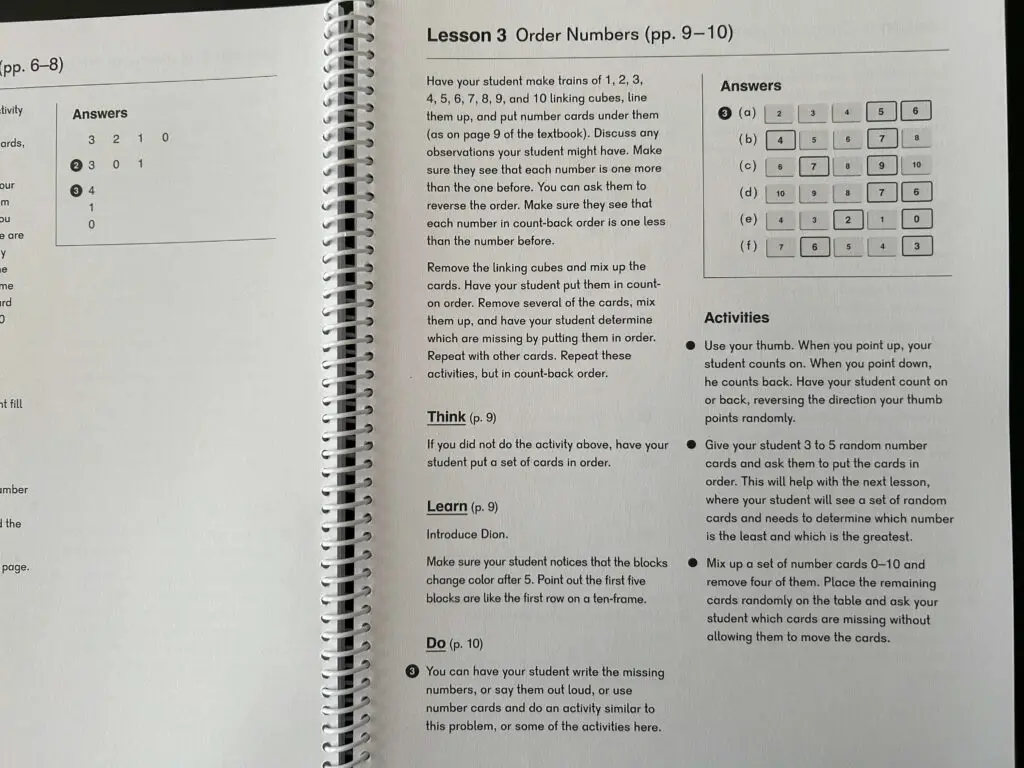
In the “learn” portion, you teach the new concept with manipulatives or pictures in the textbook.

In “Do”, your kids work through the textbook problems for practice as you watch to make sure they understand. I noticed just a bit more practice work included than there typically was in Primary Mathematics.
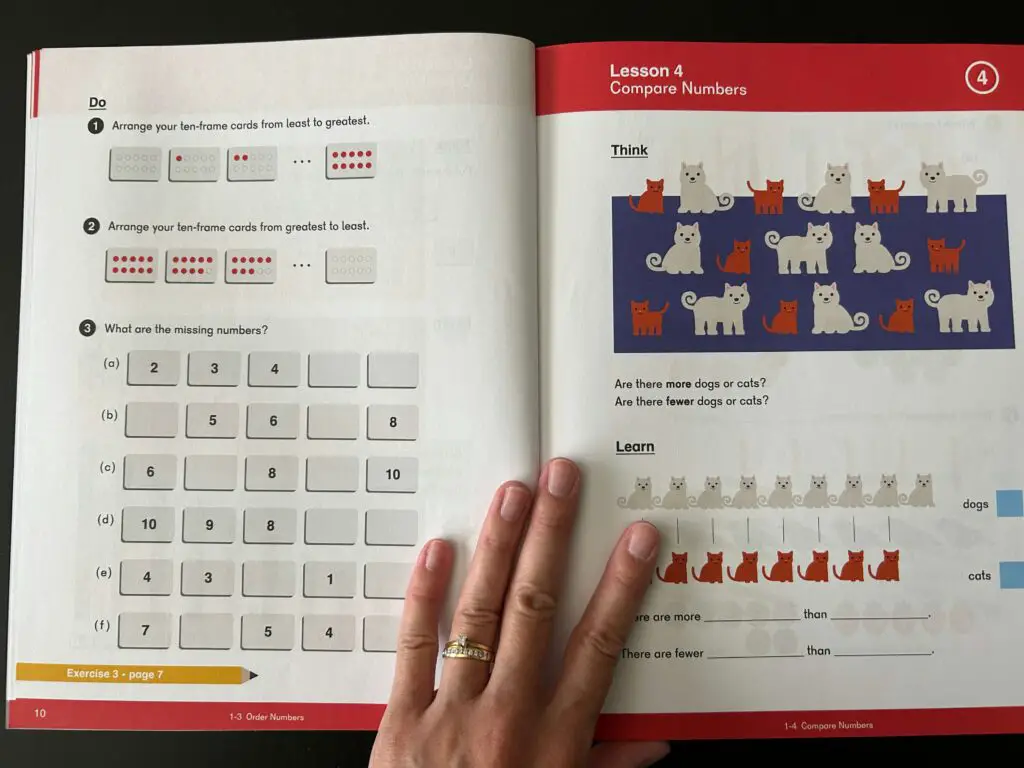
After some lessons, optional activities are included so you can use for additional practice.
After going through the textbook, you’ll pull out the workbook to complete the activities there.
The workbooks are differentiated and have 3 different sections. “Basics” reviews concepts from the entire lesson, “Practice” is just what it says, gives practice, and these tend to progress in difficulty, and then some lessons have “challenge” sections that are optional and either build on lesson ideas or push kids to problem solve in a different way.


Dimensions Math also includes Practice and Cumulative Review lessons you can work into your schedule. This is different from Primary Mathematics (which does not include these).
The Practice lessons allow students to practice concepts from the chapter lessons, and the problems increase in difficulty.

Another difference is that Dimensions Math includes tests. There are two tests for each chapter: A and B.
Test A focuses on key concepts and problem solving skills, and Test B is more application, critical thinking, and is more challenging.
You don’t necessarily have to assign grades with these if you don’t want, but the tests are good to use to see if your student is remembering concepts and mastered them. You could also use these tests over the summer for review purposes. I love the option of having them.
With these extra additions, along with the comprehensiveness and differentiation, I think Dimensions Math truly is the strongest Singapore math program on the market.
Singapore Math Approach Benefits Homeschoolers
As a homeschool mom with elementary students, I know I want them to learn to think mathematically instead of ONLY doing rote memorization.
I want them to know that math is important and learning it is achievable.
I want them to successful problem solvers with a sense of confidence, because they have a deep knowledge of the concepts they are learning.
I want to prepare them for future math courses as they continue their education…
…and I want them to have fun learning math!
If you are searching for a math curriculum that will help your kids build that deep understanding of concepts and build better problem-solving skills, I don’t think you can go wrong with Singapore math in your homeschool. It will come alongside you to accomplish all of the above.
Head to the Singapore Math website to check out what they have to offer and make this the year your kids grow more confident in their ability to do math!


Related Post
- Top 5 Kindergarten Math Concepts to Begin Teaching Your Kids
- Fun Math Games Your Kids Will Actually Want to Play
- Online Math Curriculum for a Homeschooling Win: 7 Practical Benefits
Blessed Homeschool is a participant in the Amazon Services LLC Associates Program, an affiliate advertising program designed to provide a means for sites to earn advertising fees by advertising and linking to Amazon.com. You can read my full affiliate disclosure HERE.






